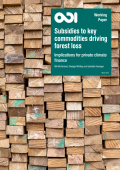
There is an increasing focus on the role that public and private resources can play in supporting activities that reduce forest loss as part of wider efforts to address climate change, and ensure sustainable development.
This report develops an analytical framework that assesses the macroeconomic, environmental and distributional consequences of energy subsidy reforms. The framework is applied to the case of Indonesia to study the consequences in this country of a gradual phase out of all energy consumption subsidies between 2012 and 2020. The energy subsidy estimates used as inputs to this modelling analysis are those calculated by the International Energy Agency, using a synthetic indicator known as "price gaps". The analysis relies on simulations made with an extended version of the OECD’s ENV-Linkages model. The phase out of energy consumption subsidies was simulated under three stylised redistribution schemes: direct payment on a per household basis, support to labour incomes, and subsidies on food products.
Domestic climate policies and the actual environmental performance differ between emerging economies. Using a fuzzy set Qualitative Comparative Analysis (QCA), this paper tests the influence of the domestic green industry, the ratio of fossil fuels to financial power, the international negotiating position, and the environmental civil society in Brazil, China, India, Indonesia, South Korea, Mexico, and South Africa. A bad ratio of domestic fossil fuel production to financial power and a weak environmental civil society are a sufficient condition for weak climate policy performance. A weak domestic green industry combined with a weak influence of the negotiations only explains some of the cases.
In recent years there has been increasing support for establishing successful models of REDD+ and low emissions development (LED) efforts at a jurisdictional scale. Jurisdictional efforts were designed to overcome the shortcomings of project-based approaches by working across land-use types and with multiple stakeholders to create models for national implementation. This study analyzes some of the most advanced REDD+/LED initiatives worldwide - including a critical look at the success and challenges to date - to understand what is needed to succeed going forward. Eight diverse jurisdictions were studied: Acre, Brazil; Berau, Indonesia; Ghana’s cocoa ecoregion; Mai Ndombe, Democratic Republic of the Congo (DRC); San Martín, Peru; São Félix do Xingu, Brazil; the Terai Arc, Nepal; and the Yucatan Peninsula, Mexico.
This paper presents a framework for a green economy transition in tourism destinations. While the literature has suggested many models to guide sustainable tourism, very few studies have investigated the green economy in a tourism context. The main distinguishing factor between the green economy and sustainable development may be described as the acknowledgement of climate change as an existential threat to society and the aim to avoid policy, management and governance fragmentation (which has been common for environmental issues) by addressing greenhouse gas emissions, resource efficiency and social inclusiveness holistically at the economic level. This study frames the green economy concept from a tourism perspective and presents a model for translating the green economy concept into a tourism stakeholder engagement process. The model was tested in the case study of Bali, Indonesia, involving research methods such as visioning group techniques with tourism stakeholders, tourism economy and employment forecasting, resource efficiency estimates as well as resident and visitor surveys.
